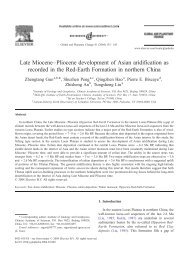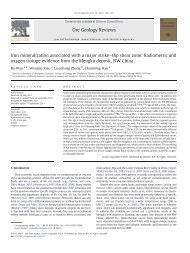constraints from fluid inclusions and Sr, C a
constraints from fluid inclusions and Sr, C a
constraints from fluid inclusions and Sr, C a
Create successful ePaper yourself
Turn your PDF publications into a flip-book with our unique Google optimized e-Paper software.
4 K. LI et al.<br />
Fig. 2. Cross section AB of the Tahe oilfield shows different formation contacts in the south <strong>and</strong> the north <strong>and</strong> water-oil distribution.<br />
(A)<br />
(B)<br />
Fig. 3. Graph of burial-thermal history of wells S109 in the south (A) <strong>and</strong> S75 in the north (B).<br />
SAMPLING AND ANALYTICAL METHODS<br />
Thirty-nine core samples <strong>from</strong> seventeen wells across the<br />
whole Tahe oilfield (Fig. 1) were collected <strong>from</strong> the Ordovician<br />
strata. The samples with veins, giant calcite crystals,<br />
or different generations of cements were chosen <strong>from</strong> the<br />
petroleum reservoirs. Petrographic <strong>and</strong> cathodoluminescence<br />
(CL) analyses were performed on 23 thin sections. A<br />
cold cathode luminescence microscope was used with a<br />
beam voltage of 16.3 kV, a current of 325 lA <strong>and</strong> a beam<br />
diameter of 4 mm. Fluid <strong>inclusions</strong> were observed under a<br />
Linkam THMSG 600 fitted a UV lamp to determine<br />
whether they were oil or aqueous <strong>inclusions</strong>. Micro-thermometric<br />
measurements were conducted using the<br />
THMSG 600 freezing ⁄ heating stage with precision of<br />
±1°C. Salinity was calculated based on the ice final melting<br />
temperature measurement using the following equation:<br />
Salinity = 0.00 + 1.78T m ) 0.0442T m 2 + 0.000557T m<br />
3<br />
(Bodnar 1993), where T m is the depression of the freezing<br />
point in degrees Celsius (°C).<br />
Fracture-fillings with a width of more than 2 mm were<br />
extracted <strong>from</strong> core using a dentist’s drill <strong>and</strong> subject to<br />
trace element analyses <strong>and</strong> carbon, oxygen, <strong>and</strong> strontium<br />
isotope measurement. For carbon <strong>and</strong> oxygen isotope analyses,<br />
about 30–50 mg of samples was reacted overnight<br />
with 100% phosphoric acid at 25°C under vacuum to<br />
release CO 2 <strong>from</strong> calcite. The CO 2 was then analyzed for<br />
carbon <strong>and</strong> oxygen isotopes on a Finnigan MAT251 mass<br />
Ó 2010 Blackwell Publishing Ltd




